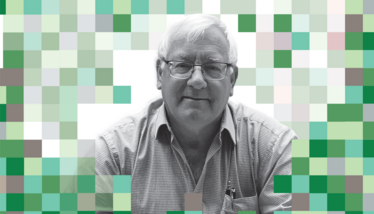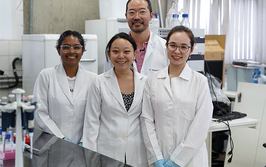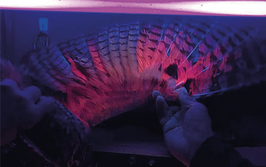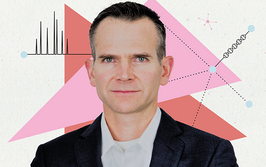A Comprehensive Success
Sitting Down With… Phil Marriott, Professor in the School of Chemistry, Monash University, Melbourne, Australia

What makes you tick – in science and elsewhere?
I thrive on challenges – and on supporting others. That feeds into my enjoyment of empowering analysts through formal teaching activities, journal publications and conference presentations. It also underscores my love of languages (I learned French – albeit poorly – at school, learned some Bahasa Malaysia, speak Cantonese – courtesy of my Malaysian wife – and studied Mandarin Chinese some years ago). And being a proud grandfather to my six grandchildren provides me with constant drive – and lots of books to read to them.
Though my “ability to tick” may have been somewhat reduced by a bad bike accident some years ago, I manage the issue in my stride. Unfortunately, my other great love – running – is also largely behind me due to a hip operation, but, before that, my thirst for challenge led me to compete in triathlons and marathons. Peter Schoenmakers and I have shared this hobby for some time. I sent him a video detailing our various runs around the world to celebrate his 65th birthday in 2019!
Tell us more about your teaching activities…
I teach undergraduate students at Monash University, run a research group that has hosted seventy-five overseas researchers, and conduct GC×GC workshops across the globe (which in turn means lots of great food experiences). I enjoyed extended visits in South Korea, China and Brazil through scientific academy research exchange programmes, involving numerous lectures to keen students. Their rationale for attending? To see the capabilities of leading-edge GC×GC technologies.
An important consideration in my teaching is the broad set of GC applications present across countries; Singapore is a hub of petrochemical research, while Brazil has a thriving natural product and essential oil research community, and Portugal is home to a wealth of environmental research. Despite differences, they share common issues, for example, access to multidimensional equipment.
Will you be at Riva 2020 (if it goes ahead)?
Of course! The ISCC meeting in Riva del Garda is by far the best specialist conference on capillary separation methods, and leads the way in GC innovation. You need only attend once to understand the attraction. I vividly recall the first time I attended. Especially the mountains with the chapel and church nestled part way up – and the Friday afternoon challenge of scaling the heights. Alongside great food, great science, and great people, it’s a truly memorable experience.
The GC×GC Symposium (of which my workshop is a part) has been a regular feature at Riva since 2005. I’d say there has never been less than 30 attendees, and – in the past few years – this has climbed to as high as 70. This is, in part, due to Pat Sandra’s input; he was instrumental in bringing the GC×GC Symposium to Riva. This provided a bona fide reason to attend for the GC community, and led to a huge spike in conference attendance. Luigi Mondello – another great GC×GC contributor – has now taken over Pat’s role.
What’s so special about comprehensive GC (besides the “pretty pictures”)?
I’d say the “pretty pictures” are definitely part of the intrigue. I organized a “GC×GC Grand Master Exhibition” at Riva one year, highlighting researchers’ GC×GC images as works of art. But the real value lies in being able to observe total sample compositions via the total volatile profile. In doping analysis, for example, this means that cheats have no place to hide – each component is displayed, with its own unique combination of retention times and MS outputs.
Resolution of potentially interfering matrix peaks allows precise quantification and qualification of analytes, and we can observe phenomena that are obscured or unapparent with GC. GC×GC is also used to screen samples when developing and characterizing new processes, acting as a sentinel method to inform which of the available GC technologies is best suited to continued analysis.
How widely is comprehensive GC used at present – do you anticipate this will change?
Almost all major GC research areas have also been investigated with GC×GC, but there is still much to investigate. Petrochemical applications are compelling due to the complex nature of the samples. In environmental analysis, GC×GC is effective in the sensitive and selective detection of pesticides, polychlorinated biphenyls, and dioxins. I may be biased, but I’d say that GC×GC could support at least one stage of the analysis cycle in any area of volatile compound research.
In the future, I expect to see applications for GC×GC in metabolomics, and further complex samples like essential oils. There is work yet to be done, however, to improve metabolite coverage for such samples. GC doesn’t display compounds that don’t resolve or are present in small amounts, and teasing them from the matrix is a devilish task. GC×GC might – or should – resolve them more effectively, especially in the case of minor compounds that are swamped by major analytes. MS structure identification also requires improvement, but this can be very difficult if spectra are not sufficiently specific.
What will it take for comprehensive GC to really take off?
The $64,000 question! A summit of users, researchers, manufacturers and regulators may help to recognize barriers to adoption, but more extensive standardized methods, improved reproducibility, enhanced user training, and employer commitment to the technique will also be necessary. We also need efforts to standardize nomenclature for the technique. The costs associated with these systems (both upfront and ongoing) also represents an issue. Some of these barriers are being addressed; others, however, require greater across-the-board collaboration from industry, regulators, and researchers.

















